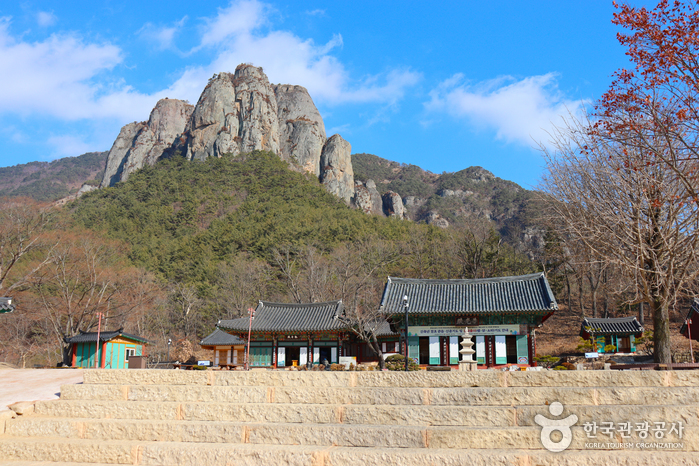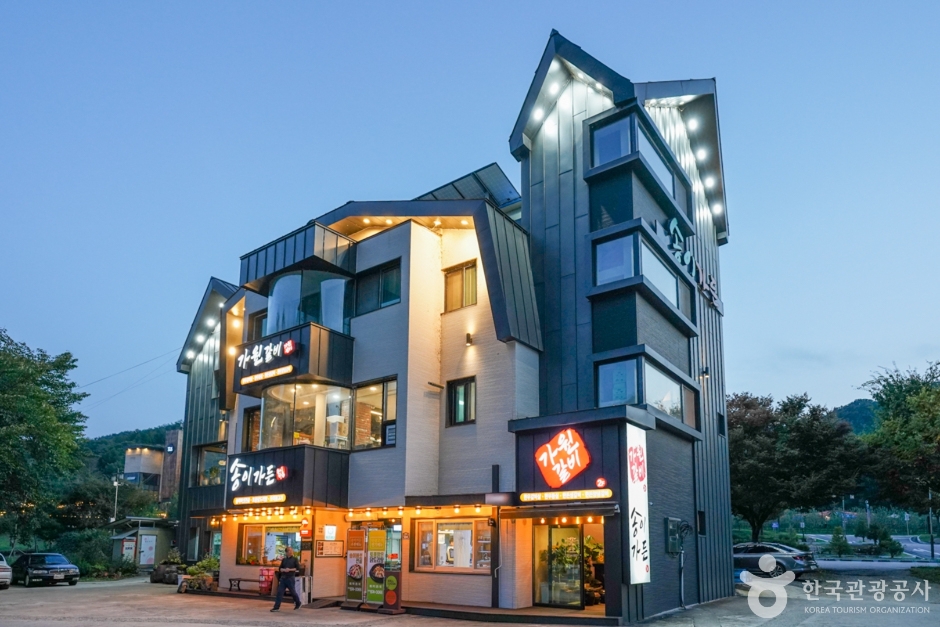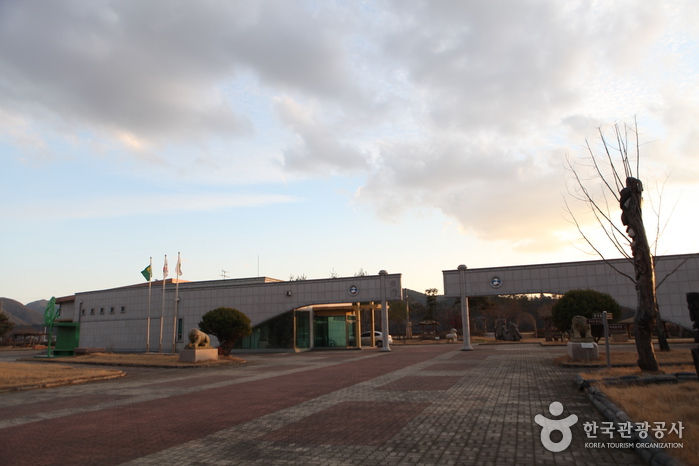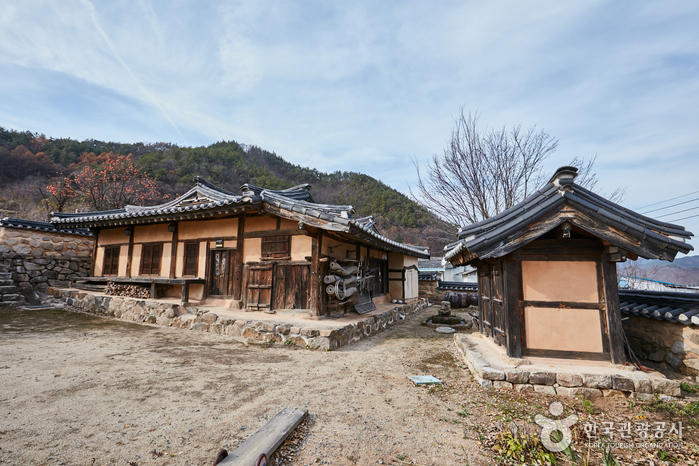Daejeonsa Temple (대전사)
0m 13481 2023-04-17
226, Gongwon-gil, Cheongsong-gun, Gyeongsangbuk-do
+82-54-873-2908
Daejeonsa Temple is said to have been built by Great Monk Uisang in the 12th year of King Munmu’s reign (672). It was rebuilt in the 13th year of King Hyeonjong’s reign (1672) after a fire destroyed the original temple complex during the Imjin War (1592-1598). During work to renovate Bogwangjeon Hall in 1976, a text that had been put up with the ridge beams was found. Bogwangjeon Hall is a small building and its ceiling is in the shape of a Chinese character that symbolize with the meaning "well" or "pavilion" that looks similar to the sharp(#) symbol. A Birojanabul Buddhist statue is enshrined in the hall.
Juwangsan National Park (주왕산국립공원)
481.1373098541327m 52576 2023-03-13
169-7, Gongwon-gil, Cheongsong-gun, Gyeongsangbuk-do
+82-54-870-5300
Juwangsan Mountain (alt. 720.6 m) is located in the Baekdudaegan Mountain Range, the backbone of the Korean peninsula. The mountain features deep valleys and many sheer rock cliffs to make it the third-largest rocky mountain in the country. Juwangsan Mountain was recognized as a tourist attraction on May 30, 1972, and became the 12th national park a few years later on March 30, 1976. The park is relatively small, filling in an area of just 105.582 ㎢ but it is great for a leisure walk with walking trails along the valleys up to waterfalls.
Juwangsan Mountain was called Seokbyeongsan Mountain during the Silla dynasty due to the many stone peaks jutting out but has been called Juwangsan Mountain since the Unified Silla period. In addition to these tall rocky peaks, Juwangsan National Park also includes four waterfalls, caves, Daejeonsa Temple, and other attractions for a comprehensive tourist site.
Three Falls of Juwangsan Mountain (주왕산 1.2.3 폭포)
1.3 Km 38475 2024-02-13
24 Sangui-ri, Juwangsan-myeon, Cheongsong-gun, Gyeongsangbuk-do
Above Haksodae Cliff in Juwangsan Mountain lie three enchanting waterfalls. The first of these falls goes by the name of Yongchupokpo Falls, where water gracefully meanders through a gorge, enveloped by encircling rocks. Roughly one kilometer further upstream, you'll encounter Jeolgupokpo Falls, accompanied by the tranquil Seonnyeotang Pond below. To the left of Jeolgupokpo Falls stands the grandeur of Yongyeonpokpo Falls, the largest and most magnificent among them. Yongyeonpokpo Falls is also famously referred to as Ssangyongchupokpo Falls, denoting its two distinct torrents of water ('ssang' meaning 'two,' and 'yongchu' signifying 'pond' in Korean). A well-maintained trekking path welcomes visitors, allowing them to explore and ascend to witness these three falls, with a gentle incline that is easily traversed by visitors of all ages.
Songi Garden (송이가든)
3.7 Km 21084 2024-02-13
504 Juwangsan-ro, Juwangsan-myeon, Cheongsong-gun, Gyeongsangbuk-do
054-874-0066
Songi Garden, a Korean restaurant positioned near the Juwangsan Tourist Complex, is celebrated for its healthy cuisine, crafted using fresh, locally sourced produce. The restaurant's standout dish, beoseot jeongol (mushroom hot pot), is particularly noteworthy for its flavorful yet light broth, brimming with an assortment of mushrooms. This culinary experience can be complemented with visits to nearby attractions such as the Cheongsong White Porcelain Experience Center and the Cheongsong Flower Stone Museum, making for a well-rounded exploration of the area's cultural and gastronomic offerings.
CheongSong folk&Arts Village [Korea Quality] / 청송 한옥민예촌 [한국관광 품질인증]
3.8 Km 6658 2020-12-12
494, Juwangsan-ro Budong-myeon, Cheongsong-gun, Gyeongsangbuk-do
+82-54-874-9098
'Cheongsong Hanok Folk Arts Village is situated within the Cheongsong Tourist Site, which is maintained and operated by the Cheongsong Culture & Tourism Foundation. The Cheongsong Tourist Site consists of the Hanok Folk Arts Village, which is an accommodation houses, Pottery Village, Exhibition Center, Museum, restaurants, and other convenient facilities. The Pottery Village provides a hands-on experience program for visitors who want to try their hand at making Cheongsong white porcelain, a renowned cultural heritage of Cheongsong, and consists of various interesting structures including a dugout hut-type workshop built with rubble and mud. The Exhibition Center consists of the Cheongsong White Porcelain Exhibition Pavilion and the Simsugwan Pottery Pavilion, while the Museum consists of the Folk Exhibition Hall, which displays a variety of Cheongsong’s traditional cultural assets, and the Ggotdol Museum, which exhibits ggotdol (naturally-patterned rocks) found only in Cheongsong. In addition, guests can use the various restaurants, seminar room, sports facilities, and nature trail located within the Cheongsong Tourist Site. Cheongsong Hanok Folk Arts Village is composed of seven hanok houses, namely, Daegamdaek, Yeonggamdaek, Jeongseungdaek, Hunjangdaek, Chambongdaek, Gyosudaek, and Saengwondaek, each of which is named after its principal characteristics. Thus, Daegamdaek, Yeonggamdaek and Jeongseungdaek have many rooms with a courtyard and a wooden floor, while Saengwondaek and Chambongdaek are simple thatched houses. Each hanok house has a different size and structure, and is equipped with high-quality antique furniture made by artisans, and bedding. Cheongsong Hanok Folk Arts Village also has special traditional spaces that are rarely found in other hanok accommodation, including a barn, warehouse, and traditional kitchen that are not currently used but which exhibit the traditional features of hanok. Each house is equipped with a modern bathroom, toiletries, and hairdryer, while communal toilets and a shower room are situated outside the houses.
Jeolgolgyegok Valley [National Geopark] (절골협곡 (청송 국가지질공원))
5.1 Km 31802 2021-02-17
San 124, Jusanji-ri, Cheongsong-gun, Gyeongsangbuk-do
+82-54-870-6111
Jeolgolgyegok Valley is located along the mountain ridgeline connecting Gamebong Peak and Wanggeoam Rock in Juwangsan Mountain. It stretches for 5 kilometers from Jeolgol Valley Visitor's Center to Daemun Bridge. The valley is formed of vocanic tuffs that were welded and compacted after cooling down, which resulted in forming vertical cracks, leaving rocks to fall out and create a steep valley cliff.
Jusanji Pond [National Geopark] (주산지 (청송 국가지질공원))
5.4 Km 27616 2022-12-26
Jusanji-ri, Cheongsong-gun, Gyeongsangbuk-do
+82-54-870-6111
Jusanji Pond is a small reservoir located in Juwangsan National Park. It is a man-made pond that was dug out in August, 1720 and completed in October the year after. The pond has been used as a source of water for agricultural use as well as for drinking water. Even though it is small in size, about 200 meters long and 8 meters deep, the pond has never dried up from any drought.
150-year-old willow trees are rooted in the pond, which makes a fantastic balance with the surroundings, creating a picturesque scenery found nowhere else.
Cheongsong Folk Museum (청송민속박물관)
5.6 Km 9111 2022-08-05
222, Juwangsan-ro, Cheongsong-gun, Gyeongsangbuk-do
+82-54-874-9321
Cheongsong Folk Museum was opened in 1999 to promote the history, culture, and customs of the region. The three-story museum offers indoor & outdoor exhibition halls.
The indoor exhibition halls showcase educational materials related to farming and the customs of Cheongsong. Exhibitions - such as the Traditional Guest Room, Weaving Room, Items of Everyday Use, and Cheongsong Porcelain - offer glimpses of how people lived in the past. The outdoor exhibition space reproduces a traditional tavern, waterwheel, millstone operated by a horse or ox, monument to ward off misfortunes and protect prosperity, and natural stones used for worship, with which visitors can experience farm life in the past.
Juwangsan Mountain Seongcheondaek
6.9 Km 10745 2021-04-09
12, Seodang-gil Cheongsong-eup, Cheongsong-gun, Gyeongsangbuk-do
+82-10-6711-6427
Seongcheondaek House with about 300 years' history is an old hanok guesthouse located in Cheongun-ri at the entrance to Juwangsan Mountain, which can be reached by driving along Yongjeoncheon Stream from Cheongsong County in Gyeongsangbuk-do. With the tranquil surrounding atmosphere among houses in the alley, the house features a typical square-shaped structure of the mountain region.
Seongcheondaek House is presumed to have been bought by Im Chun-seop, a high-ranking official during the reign of King Gojong (r. 1863-1907) of the Joseon Dynasty, but its exact construction date is unknown. It was designated as National Folklore Cultural Heritage No. 172 in 1984.
This cozy hanok house consists of the main gate with straw-thatched roof, square-shaped Anchae (Women’s Quarters), middle gate, Sarangbang (master’s room), tea room, old stable, Daecheongmaru (hall between rooms) overlooking the courtyard with beautiful scenery, and so on. In particular, guests can enjoy a romantic atmosphere from Daecheongmaru by appreciating the scene of falling raindrops or melting snow from the edges of the eaves.
The Munganchae (gate building) consisting of a bathroom and a kitchen has a straw-thatched roof and a renovated interior for the guests’ convenience. The square-shaped Anchae is composed of two guestrooms (Sarangbang and Anbang) and a reading room (Utbang). The rooms feature a traditional construction style with cozy and clean interior items including a small wooden table as well as clean beddings. In addition, a kitchen is situated in front of Anbang, displaying traditional kitchen appliances including a fireplace and two large iron pots, unlike a modern-style kitchen in Munganchae. Daecheongmaru of Anchae offers an open view of the outdoor landscape through two large wooden windows. In addition, a deep groove in the middle of the yard in front of Daecheongmaru catches one’s eyes. The groove is said to have been made due to the rubbing of the foot on the ground when weaving hemp cloth hundreds of years ago.
Guests can enjoy relaxation both during daytime and nighttime under a starry sky in the yard where a small wooden bedstead and a stone table are situated. Moreover, the house provides folk games such as neolttwigi (Korean see-sawing game) and tuho (pitch-pot) as well as the family art therapy program wherein family members can understand each other better through a painting and drawing activity. Surrounding tourist attractions include Juwangsan National Park and Jusanji Reservoir.
Dalgi Mineral Spring [National Geopark] (달기약수탕 (청송 국가지질공원))
7.2 Km 17190 2021-06-24
16, Yaksu-gil, Cheongsong-gun, Gyeongsangbuk-do
+82-54-870-6111
Dalgi Mineral Spring was found approximately 130 years ago during construction of a waterway. The carbonated water has various minerals that help treat multiple diseases. The water is formed when rain water gets absorbed underground and meets carbon dioxide from the magma deep below.



![CheongSong folk&Arts Village [Korea Quality] / 청송 한옥민예촌 [한국관광 품질인증]](http://tong.visitkorea.or.kr/cms/resource/14/2048414_image2_1.jpg)
![Jusanji Pond [National Geopark] (주산지 (청송 국가지질공원))](http://tong.visitkorea.or.kr/cms/resource/84/2616884_image2_1.jpg)


![Dalgi Mineral Spring [National Geopark] (달기약수탕 (청송 국가지질공원))](http://tong.visitkorea.or.kr/cms/resource/16/2703516_image2_1.jpg)
 English
English
 한국어
한국어 日本語
日本語 中文(简体)
中文(简体) Deutsch
Deutsch Français
Français Español
Español Русский
Русский